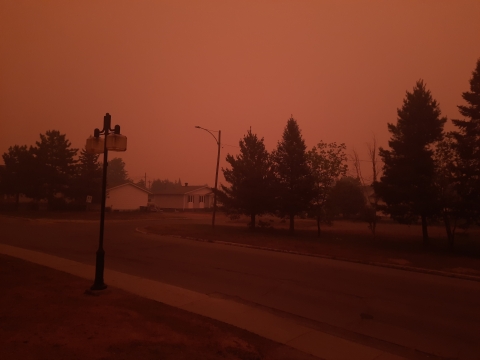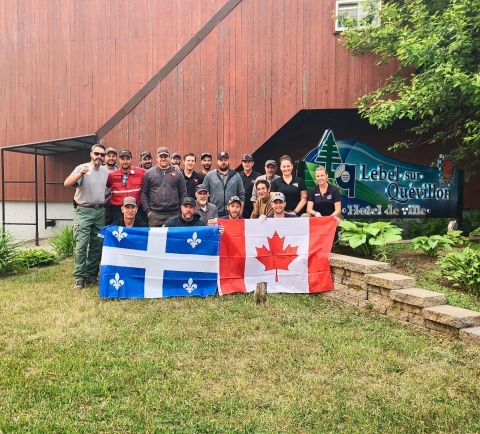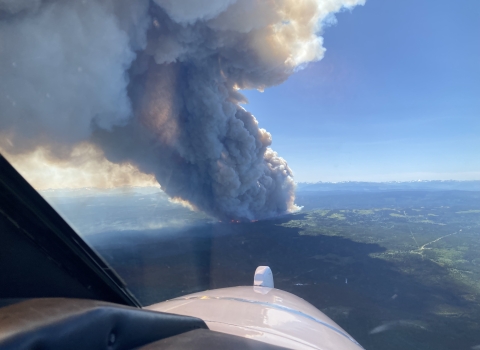Wildfires in Canada have burned a staggering 30 million acres so far this year, an area the size of Mississippi. On average, Canada’s peak fire season will go through the middle of August. Canada’s worst fire history on record was in 1989 when fires burned over 18 million acres.
By the end of July, Canada’s 2023 fire season still showed no signs of slowing. Hot, dry conditions continue to fuel wildfires, mostly in Canada’s boreal forests, with some of the largest blazes burning in Northwest Canada and Quebec. Since the spring, fires have forced over 120,000 individuals to evacuate their homes, stretching firefighting resources thin, and filling the skies with thick smoke that routinely blots out the sun.
Since May 8, the U.S. has mobilized a total of 2,235 personnel to Canada. As part of the Southwest Area Incident Management Team (IMT), Carl Schwope was among that group. Schwope, the Fire Management Officer for Balcones Fire Zone in Texas for the U.S. Fish and Wildlife Service (USFWS), serves as the Incident Commander (IC) for the Southwest Area IMT.
Upon their arrival in Canada, the team was assigned to the province of Quebec, where they set up the Incident Command Post in Lebel-sur-Quévillon. When Schwope arrived, the town of about 2,000 people had already been evacuated.
“It was like entering a ghost town,” recalls Schwope. “And, once you leave the city limits, there’s nothing for hours and hours. We set up the Incident Command Post in the community center, which is also where we slept.”
The Southwest Area IMT was assigned management of the Lebel-sur-Quévillon Complex, a complex made up of 17 individual fires and included about 600,000 acres of wildfire. By the end of their assignment, wildfire acres on that complex would balloon to 1.5 million acres.
“Managing 17 fires seems pretty overwhelming when you look at the big picture,” said Schwope. “Societe De Protection Des Forets, Quebec’s provincial firefighting agency, was very clear on their priorities and that really helped us determine best management actions.”
The Southwest Area IMT’s top priority was to save the towns of Lebel-sur-Quévillon and Senneterre from wildfire. Throughout their entire assignment, Societe De Protection Des Forets (SOPFEU) never changed or waivered on their top priority. However, if the Southwest Area IMT met the first priority, they could then focus on protection of communication towers, utility infrastructure, railways, and recreational attractions. The clarity and consistency of these priorities provided a path for decisions and management actions.
As part of his duties as the IC for the Southwest Area IMT, Schwope is responsible for understanding how Quebec manages their wildfires and then matching that information with what his team was accustomed to and managing the expectations between the two countries’ systems. Schwope used the concept of a spike camp spike camp
In wildland firefighting operations, a spike camp is a smaller camp separate from the main fire camp. Spike camps generally draw their supplies and food from the main camp and are used to support operation areas that require personnel to travel extended distances to return to the main camp.
Learn more about spike camp to paint a clearer picture of this concept. “Spike camps are very common in the U.S.,” said Schwope. “In Quebec, they don’t utilize them. Why don’t they? Is it because they don’t have the capacity to support them? Or is it because the bugs are so brutal you simply can’t camp out? Or, maybe it’s because the area is so remote, there’s no way you could resupply and support a spike camp. Understanding the ‘why’ really helped us manage expectations and better know how to support the wildfire suppression effort effectively.”
Another distinct difference in wildland fire operations in Quebec is the use of supply caches. In the U.S., there are wildland firefighting supply caches sprinkled throughout different parts of the country to efficiently supply wildland fire operations in some of the most fire prone areas. Quebec relied on a different system in which supplies are physically purchased at the nearest specialty shop. Through this type of system, Quebec’s ability to quickly obtain heavy equipment and other types of vehicles used in wildland fire was extremely proficient and reliable. Operating with the understanding that supplies would trickle in at different timeframes rather than all at once allowed the Southwest Area IMT to adjust to these parameters.
Yet still, one of the most unique differences in fighting fire in Quebec was their use of helicopters.
“All helicopters residing in Quebec were assigned to wildfire missions,” stated Schwope. “No matter what fire experience that helicopter and pilot had, they were now reassigned to help fight fire.” Helicopter pilots who had never operated on wildfire missions were trained and put through practice exercises so they could later assist with reconnaissance flights, water bucket drops, and fire crew transport.
When asked to sum up his experience and share his biggest takeaway, Schwope answered quickly.
“Prioritization. It’s the solution to everything,” Schwope says. “We would never have been able to make progress on anything if every time the winds changed, we ran off and adjusted our priorities. Quebec authorities never once waivered on the priorities and that truly made us successful.”






